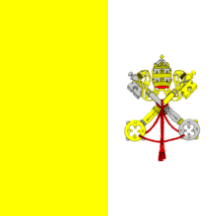 (1:1)
(1:1)
by Željko Heimer, 11 October 2004

Last modified: 2005-05-28 by dov gutterman
Keywords: vatican | holy see | pope | europe | keys |
Links: FOTW homepage |
search |
disclaimer and copyright |
write us |
mirrors
 (1:1)
(1:1)
by Željko Heimer, 11 October 2004
Official Name: The Holy See (State of the
Vatican City) - Santa Sede (Stato della Citta del Vaticano)
Capital: Vatican City
Location: Enclave of Rome (Italy)
Government Type: Ecclesiastical
Flag adopted: 8
June 1929 (Introduced in 1825)
Coat of Arms adopted: 7 June 1929
ISO Code: VA
See also:
Other sites:
There seem to be a confusion between the Vatican City State,
the minuscule state that exists only since 1929, and the Holy See
(of Rome), which is the entity which is active in all
international relationships except those of a clearly territorial
nature, such as membership of UPU (Universal Postal Union),
INTELSAT, CEPT and UNIDROIT (International Institute for the
Unification of Private Law).
No government would have much interest in relations with so tiny
a state as Vatican City. But 172 states maintain diplomatic
relations with the Holy See, and half of those that have
accredited their ambassador to the Holy See find it worthwhile to
have him or her resident in Rome, distinct from their ambassador
to the Italian Republic.
The flag of the Vatican City State is as on your webpage, showing
the arms with the silver key in the dexter position. When
what is represented is the Holy See, not Vatican City State, the
keys are reversed. Rather, when the state was set up in
1929, the keys in the arms of the Holy
See, with the gold one in dexter position, were reversed to
provide a distinctive symbol for the new entity. In the
personal arms of the popes, the keys are, of course, arranged as
in the arms of the Holy See: the other arrangement would be
equivalent to treating him as merely the head of that little
state. The arrangement for the Holy See is seen in the arms of Pope John Paul II on your webpage.
Rather than "the keys of paradise", as given on your
page, the reference would be better expressed exactly as in
Jesus' words to Peter in St Matthew's Gospel 16:19 "I will
give you the keys of the kingdom of heaven."
I doubt too the exactness of the description given of the papal
flag in use before the Napoleonic occupation of Rome. The
flag used then was that of the city of Rome, which, if I rightly
recall what is today displayed in Rome, is not "yellow and
red" but gold (yellow) and purple, as it no doubt was also
in 1848 and before 1808.
"nuntius" , 14 Febuary 2000
The Vatican has citizens (1500 persons), but there is nobody
with only Vatican citizenship. For example, the Pope is citizen
of both the Vatican and Poland. The other peculiarity is that the
Vatican issues only diplomatic passports, so this is a country,
where all the citizens are diplomats.
Maxval, 14 March 2001
I would suppose the Holy See could be considered to be part of
the government of the Vatican City State, which does have a small
territory.
Elias Granqvist, 15 March 2001
US Department of State's background notes on the Holy See
explain the situation this way:
"The term "Holy See" refers to the composite of
the authority, jurisdiction, and sovereignty vested in the Pope
and his advisers to direct the worldwide Roman Catholic Church.
As the "central government" of the Roman Catholic
Church, the Holy See has a legal personality that allows it to
enter into treaties as the juridical equal of a state and to send
and receive diplomatic representatives. The Holy See has formal
diplomatic relations with 166 nations, including the United
States. Libya, Guyana, and Angola established diplomatic
relations in 1997. Created in 1929 to administer properties
belonging to the Holy See in Rome, the State of the Vatican City
is recognized under international law and enters into
international agreements. Unlike the Holy See, it does not
receive or send diplomatic representatives."
Joe McMillan, 15 March 2001
I notice that the Vatican is listed as "Holy See" in a list of UN observers at the UN site. Is this used as an alternative name only, or does it